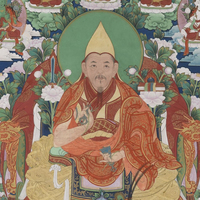
Changkya Rolpe Dorje
The Third Changkya, Rolpe Dorje (lCang-skya rol-pa'i rdo-rje, 1717-1786) was born into an ethnically Monguor (Tib. Tu) family residing in the area of Langru (Lang-gru), located in modern-day Liangzhou in Gansu province. This is an area that has not only been a meeting point of Tibetan, Mongolian, Tangut and Chinese culture for hundreds of years, but is renowned for its contributions to Tibetan culture and religion. Exhibiting early signs of spiritual prowess, his recognition at the age of three as the reincarnation of the previous Changkya Khutugtu established him within a lineage deeply respected in both Tibet and Mongolia. “Khutugtu” is a title granted by the Manchu emperors to reincarnate lamas as administrators of various regions within their realm.
Rolpe Dorje was taken to Gonlung Jampa Ling Monastery (dGon-lung byams-pa gling) to commence his education. A few years later, however, as the Qing army destroyed villages and monasteries in the region as a reprisal against those perceived to have rebelled against Manchu supremacy, the Yongzheng Emperor invited him to the imperial court in China. There, together with the Emperor’s son, who later was enthroned as the Qianlong Emperor, he was taught Manchu, Mongolian and Chinese.
Educated to act as an intermediary between the Manchu rulers and the Tibetan Buddhists of Amdo, Tibet, and Mongolia, he was sent by the Yongzheng Emperor to accompany the Seventh Dalai Lama on his return to Lhasa from exile in China, thus establishing a close relation with the Seventh Dalai Lama. Shortly thereafter, upon the death of the Emperor and the enthronement of Qianlong, Rolpe Dorje was recalled to Beijing and appointed as administrative lama to the capital. A few years later, the new Emperor commissioned him to oversee the Mongolian translation of the Tengyur from Tibetan. As part of this project, Rolpe Dorje supervised the compilation of a large Tibetan-Mongolian lexicon, A Lexicon Resource for the Learned (Dag-yig mkhas-pa’i ‘byung gnas). Subsequently, he was commissioned by the Emperor to supervise the conversion of his father’s palace into the Yungho Monastery for Manchu, Mongolian and Tibetan monks.
Rolpe Dorje’s close relationship with the Qianlong Emperor manifested in both religious and secular affairs. Thus, he was appointed by the Emperor as his Buddhist tutor and not only taught him lam-rim but also conferred upon him the Five-Deity Chakrasamvara initiation. When the secular leader in Lhasa, Gyurme Namgyal (‘Gyur-med rNam-rgyal) was executed and the Manchu amban representative murdered, Rolpe Dorje convinced Qianlong to transfer political rule to the Seventh Dalai Lama. Several years later, upon the death of the Seventh Dalai Lama, Rolpe Dorje compiled his biography and helped identify the Eighth Dalai Lama.
His diplomatic prowess also extended to Mongolia, where Qianlong sent him to convince the Second Jebtsundampa Khutugtu to quell a possible uprising when his brother had been executed. He later conferred the novice vows on the newly identified Third Jebtsundampa.
He shared with the Qianlong Emperor a great interest in making Buddhism available in the many languages of the Empire, especially in Manchu. Together with the Emperor, he supervised the compilation of a polyglot lexicon of terms in Manchu, Tibetan (both in Tibetan and Manchu script), Mongolian, Chinese and Chagatay Turkic (the language of the Uighurs), called A Clear Mirror for the Manchu Language Conjoined with Four (Other) Languages and Compiled by the Emperor (rGyal-pos mdzad-pa’i skad-bzhi shan-sbyar-gyi man-dzu’i skad gsal ba’i me-long). Qianlong also commissioned him to oversee the translation of the large Shūramgana Sutra from Chinese into Manchu. From Manchu, it was then translated into Mongolian and from Mongolian into Tibetan. Later, Rolpe Dorje oversaw the groundbreaking translation of the Kangyur into Manchu. Only the Vinaya section was translated directly from Tibetan, the rest was taken from the Chinese renderings of the Tibetan texts. Both Rolpe Dorje and Qianlong personally checked the translations before finalizing them.
Rolpe Dorje was also a prolific author. His collected works in seven volumes contain over 200 texts. They are primarily commentaries on tantric rituals but include his monumental work on the Buddhist and Indian non-Buddhist tenet systems, The Tenet Systems, Beautiful Adornment of the Mount Meru of the Sage’s Teachings (Grub-mtha’ thub bstan lhun-po’i mdzes rgyan).
Rolpe Dorje’s main teachers included the Sixth Panchen Lama (Pan-chen Blo-bzang dPal-ldan Ye-shes) and Purchog Ngawang Jampa (Phur-lcog Ngag-dbang byams-pa). His main disciples included Thuken Losang Chokyi Nyima (Thu’u-bkwan Blo-bzang Chos-kyi Nyi-ma) and the Second Jamyang Zhepa Konchog Jigme Wangpo (‘Jam-dbyang bzhad-pa dKon-mchog ‘Jigs-med dbang-po) – all luminaries of Tibetan Buddhism.
Changkya Rolpe Dorje passed away in 1786 at the age of 69.